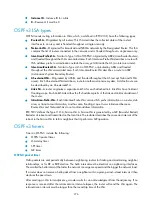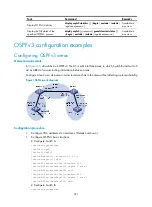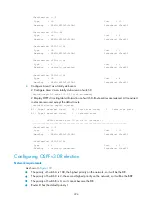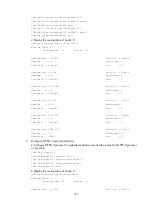
284
•
Using the
filter-policy
export
command filters routes redistributed with the
import-route
command.
If the
import-route
command is not configured, executing the
filter-policy export
command does
not take effect.
To configure OSPFv3 route redistribution:
Step Command
Remarks
1.
Enter system view.
system-view
N/A
2.
Enter OSPFv3 view.
ospfv3
[
process-id
]
N/A
3.
Specify a default cost for
redistributed routes.
default cost
value
Optional.
1 by default.
4.
Redistribute routes from
another protocol, or another
OSPFv3 process.
import-route
protocol
[
process-id
|
allow-ibgp
]
[
cost
value
|
route-policy
route-policy-name
|
type
type
] *
Not configured by
default.
5.
Inject a default route.
default-route-advertise
[
always
|
cost
value
|
type
type
|
route-policy
route-policy-name
] *
Optional.
Not injected by
default.
6.
Filter redistributed routes.
filter-policy
{
acl6-number
|
ipv6-prefix
ipv6-prefix-name
}
export
[
isisv6
process-id
|
ospfv3
process-id
|
ripng
process-id
|
bgp4+
|
direct
|
static
]
Optional.
Not configured by
default.
Tuning and optimizing OSPFv3 networks
This section describes configurations of OSPFv3 timers, interface DR priority, MTU check ignorance for
DD packets, and disabling interfaces from sending OSPFv3 packets.
The following are OSPFv3 timers:
•
Packet timer
—Specified to adjust topology convergence speed and network load.
•
LSA delay timer
—Specified especially for low-speed links.
•
SPF timer
—Specified to protect networks from being overloaded due to frequent network changes.
For a broadcast network, you can configure DR priorities for interfaces to affect DR or BDR election.
After an interface is disabled from sending OSPFv3 packets, other routers cannot obtain any information
from the interface.
Configuration prerequisites
Before you tune and optimize OSPFv3 networks, complete the following tasks:
•
Enable IPv6 packet forwarding.
•
Configure OSPFv3 basic functions.
Configuring OSPFv3 timers
Step Command
Remarks
1.
Enter system view.
system-view
N/A






























